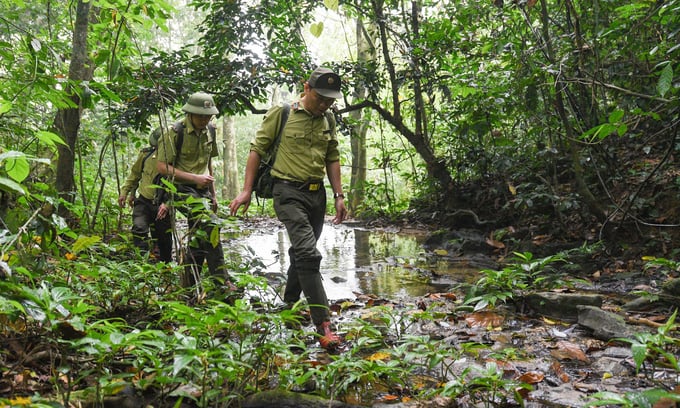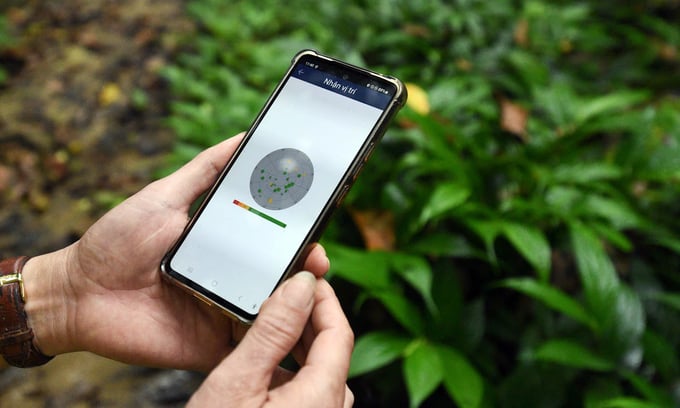November 25, 2025 | 13:38 GMT +7
November 25, 2025 | 13:38 GMT +7
Hotline: 0913.378.918
November 25, 2025 | 13:38 GMT +7
Hotline: 0913.378.918

Each ranger carries compact luggage and enough equipment for about 5-7 days of patrol in the forest. Photo: Tung Dinh.
The limestone mountains appear to stop on the side of the Tam Diep mountain range, after only one hour's drive from Thanh Hoa city to the southwest. Ngo Xuan Thang, Deputy Director of the Management Board of Xuan Lien Nature Reserve, said with great excitement, "The 24,000-ha reserve is so unique because it is the most significant place in Tonkin that retains the ecosystem of evergreen broad-leaved forest on the low mountain".
From the top view, the entire Xuan Lien Nature Reserve premise appears teeny-tiny in the heart of the Central low mountain region. The mountain range stretches from Sam Neua (Laos) to Thuong Xuan then Nhu Xuan, creating several significant mountain peaks like Ta Leo (1,400 m), Pu Gio (1,620 m), and Pu Hon (1,208 m), among others.
Until 2019, Xuan Lien Nature Reserve documented 1,228 vascular plants from 659 genera, 181 families, and 5 phyla. Many of these species, including selasian wood, cunninghamia konishii, fokienia, and madhuca pasquieri, are listed in Vietnam's Red Book.

GPS devices are used by forest rangers during the forest patrolling. Photo: Tung Dinh.
"We have used the GPS-Photo Link app to record rare and ancient tree species such as yunnan cypress, fokienia, cunninghamia konishii, madhuca pasquieri, and others for close monitoring and management. We even use valuable wooden roots as landmarks to mark sub-zones," Thang explained.
The deputy director took the team to Hon Can Ranger Station to check out the ranger force's "technological friend". Thang took the crew on a random route through the forest to assess the woodland's actual state.

The Roosevelt's muntjac is recorded at Xuan Lien Nature Reserve.
Thang called for the team of Nguyen Van Binh, a resident of Quang village (Van Xuan commune) to instruct them on how to utilize GPS in practice. People in the village use sharp stakes and ropes to divide the forest into 1,000m2 small plots in order to calculate and measure the radius of the trees and press the coordinates.
People like Binh now consider patrols to be their daily work. Some of them even wonder whether they will be able to count all the trees in Xuan Lien forest until the end of their lives. "A day without visiting my inheritance makes me feel like something's missing," he said. And when Binh learned how to "count the treetops" and realized how valuable his "treasure" was, he fell even more in love with the 5 layers of evergreen forest.
Thang stated that even on the hottest of days, the temperature in the forest patrol area seldom rises above 40oC. With an average annual rainfall of over 2,000mm and air humidity always between 85 and 86%, Xuan Lien becomes home to 1,811 species of animals, 29 of which are internationally vulnerable and listed on the IUCN Red List, and 50 of which are listed in the Vietnam Red Book.
Mr. Thang picked up wild vegetables with his hand and slowly talked about the typical and endemic species of Xuan Lien such as the white-cheeked gibbon, gray langur, Roosevelt's muntjac, red-faced spider monkey, Northern Cuora galbinifrons. He has seen some species, but the majority of them can only be viewed in the wild through images captured in heat traps.

Forest patrol and protection are currently contracted to many households living in the buffer zone. Photo: Tung Dinh.
The finding of Roosevelt in 2012 and 2013 is the most unforgettable memory for Xuan Lien environmentalists. At the time, the Center for Natural Resources and Environment Research and reserve employees spent several years wading through the forest to confirm the existence of two species of gills found in Xuan Lien, the common muntjac and Roosevelt's muntjac.
These two species were previously identified in the 1990s in the area next to Xuan Lien Nature Reserve - Pu Hoat Nature Reserve, Nghe An. However, due to a lack of information, Roosevelt's muntjac was mistakenly described as a new species and named Pu Hoat muntjac for a long time.
It wasn't until the 2012 investigation, when scientists compared the skulls collected at Xuan Lien to those kept at the American Museum of Natural History and the Chicago Field Museum of Natural History, as well as the genetic sequencing of dozens of genetic samples obtained in Xuan Lien, Pu Hoat, that scientists came to the conclusion, reaffirming Pu Hoat muntjac is the Roosevelt's.
Xuan Lien's conservation work also demonstrated effectiveness when increasing the number of white-cheeked gibbons from 41 herds of 129 individuals (by 2013) to 62 herds of 200 individuals (by 2020), and 8 groups of gray langurs with approximately 151 - 224 individuals identified.
Furthermore, two new plant species have been discovered here: one belonging to the Aristolochiaceae family and scientifically named Aristolochia xuanlienensis (Xuan Lien wood incense); the remaining species belong to the genus Giac Di - Annonaceae family and are awaiting DNA analysis results.
After various changes, the Xuan Lien Nature Reserve now manages 24,728.6 hectares of forest and forestry land, of which 23,816.23 ha is special-use forest and 912.37 ha is designated for production forest. Natural forests cover nearly 97% of Xuan Lien.
After planning three types of forests in Thanh Hoa province from 2016 to 2025, the reserve's production forest land expanded by 92.77ha. The reserve's functional subdivisions are separated into relatively adjacent sections that are thought to be convenient for management and preservation.
Translated by Linh Linh

(VAN) Heavy rains make aquatic species more vulnerable to disease. Proactive water management and high-tech systems help farmers prevent outbreaks and protect yields.

(VAN) Greenhouses are shifting production mindsets in Binh Lu commune, enabling farmers to ‘weather the sun and rain’ and secure stable vegetable harvests throughout the year.

(VAN) Green transition is crucial for the Mekong Delta amid climate change and stricter standards, offering a path toward sustainability.

(VAN) Dong Thap promotes agricultural restructuring, forms large specialized farming zones, raises the value of agricultural products and develops toward ecological and high-tech directions.
/2025/11/22/4018-4-213342_747.jpg)
(VAN) The Mekong Delta Agricultural Experts Club has attracted 143 experts and researchers to participate in providing consultancy and contributing initiatives to the development of one million hectares of high-quality rice.

(VAN) Ca Mau’s development of OCOP products opens a path to increasing cooperatives value, helping boost income, expand markets, and affirm collective economy's role.

(VAN) Turning seemingly ordinary coconut shells into unique jewelry and artwork, Nguyen Bang Nhi spreads the value of local culture through her brand, Cocohand.